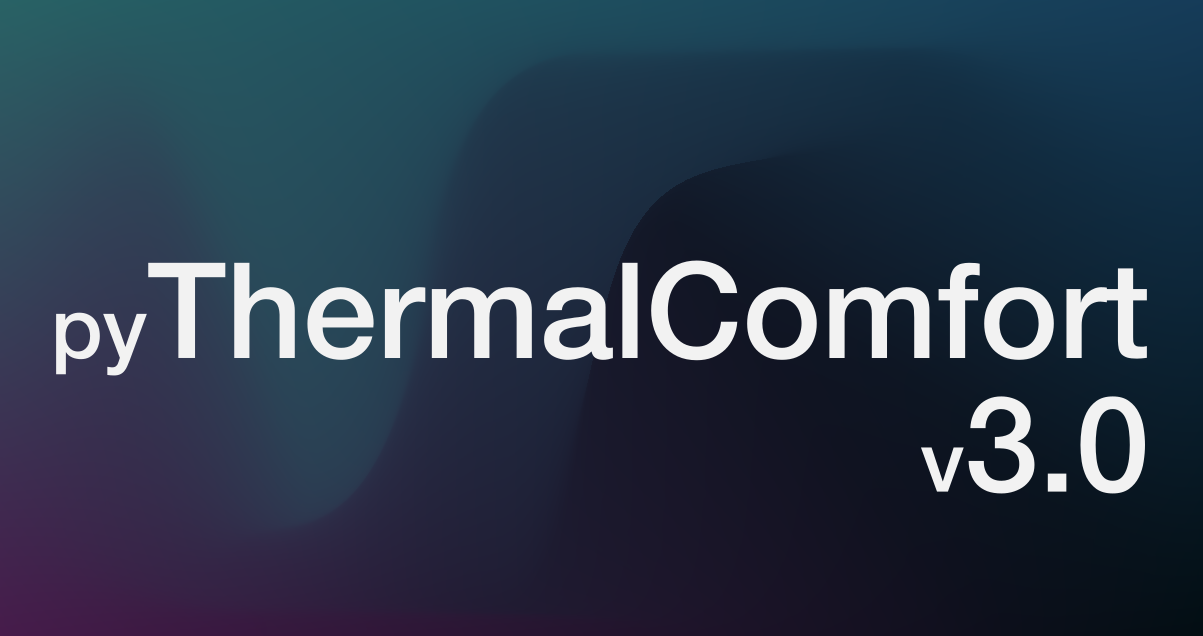pythermalcomfort v3.0 is Here! 🚀

Why Should You Use pythermalcomfort?
The thermal environment significantly affects thermal comfort, occupant well-being, health, and productivity. However, calculating thermal comfort, heat, or cold stress indices can be complex and time-consuming. That’s where pythermalcomfort comes in. This Python package simplifies the process by providing accurate, standards-compliant calculations for thermal comfort and heat/cold stress indices.
What’s New in pythermalcomfort v3.0?
Version 3.0 is a major leap forward, packed with new features and improvements:
-
Multi-node models Pythermalcomfort now includes JOS3 a multi-node model to estimate physiological variables (e.g., skin temperature, core temperature, and skin wettedness)
-
Structured Results with Dataclasses
Functions now return dataclass instances, making it easier to access and organize results. For example:from pythermalcomfort.models import pmv_ppd_iso
result = pmv_ppd_iso(tdb=[22, 25], tr=25, vr=0.1, rh=50, met=1.4, clo=0.5, model='7730-2005')
print(result.pmv)
print(result.ppd)This change enhances readability and usability, especially when working with multiple outputs.
-
Updated Function Names and Organization
- PMV functions are now named consistently (e.g.,
pmv_ppd_ashrae,pmv_ppd_iso). - Psychrometric functions have been moved to
utilities.pyfor better organization.
- PMV functions are now named consistently (e.g.,
-
Array as inputs
All functions now accept arrays as inputs, enabling faster batch processing of multiple inputs. -
Enhanced Documentation and Testing
- More examples and detailed descriptions of models.
- Added input validation to ensure inputs are within model applicability limits.
-
New Features
- Added surveys to assess thermal comfort in the documentation.
- Included a detailed section on clothing insulation.
How to Get Started
Using pythermalcomfort v3.0 is easier than ever. Here’s a simple example to calculate PMV (Predicted Mean Vote) using the ISO 7730 standard:
from pythermalcomfort.models import pmv_ppd_iso
# Input parameters
result = pmv_ppd_iso(tdb=[22, 25], tr=25, vr=0.1, rh=50, met=1.4, clo=0.5, model='7730-2005')
# Access results
print("PMV:", result.pmv)
print("PPD:", result.ppd)
This example demonstrates how straightforward it is to perform thermal comfort calculations with pythermalcomfort.
How to Cite pythermalcomfort
If you are using pythermalcomfort please cite the package as follows: Tartarini, F., Schiavon, S., 2020. pythermalcomfort: A Python package for thermal comfort research. SoftwareX 12, 100578. https://doi.org/10.1016/j.softx.2020.100578
Please also do not forget to cite the specific model you are using.
Upgrading from to v2.0 to v3.0?
Please note that pythermalcomfort v3.0 introduces several breaking changes, including updated function names and structured results. Hence, this upgrade may require adjustments to your existing codebase.
#ThermalComfort #BuildingScience #Python #HVAC #pythermalcomfort #heat #heatstress #coldstress
